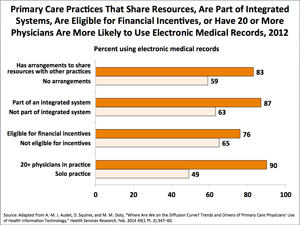Synopsis
Adoption of health information technology (HIT) by physician practices rose considerably from 2009 to 2012, yet solo physicians lag practices of 20 or more and certain functions—like electronically exchanging information with other physicians—have been adopted by only a minority of providers. Physicians who are part of an integrated delivery system, share resources with other practices, and are eligible for financial incentives, have higher rates of HIT adoption.
The Issue
Doctors are using HIT in greater numbers, spurred on in part by the Health Information Technology for Economic and Clinical Health (HITECH) Act of 2009, which provided billions to help build a national HIT infrastructure. Commonwealth Fund researchers analyzed data from surveys of primary care physicians conducted in 2009 and 2012 to check on the progress of HIT adoption and to see how certain factors—like being part of an integrated health system or using shared technical assistance programs—can influence technology take-up.
Key Findings
- From 2009 to 2012, the rate of adoption of electronic medical records (EMRs) by U.S. primary care physicians increased by half, from 46 percent to 69 percent. HIT use rose particularly in order entry management: the proportion of physicians able to send prescriptions electronically to pharmacies nearly doubled, from 34 percent to 66 percent; electronic prescribing increased from 40 percent to 64 percent; and electronic ordering of lab tests grew from 38 percent to 54 percent.
- In 2012, 33 percent of primary care physicians could exchange clinical summaries with other doctors, and 35 percent could share lab or diagnostic tests with doctors outside their practice.
- As of 2012, a minority of physicians provided electronic access for patients. Roughly one-third or fewer allowed patients to electronically view test results, make appointments, or request prescription refills.
- Practice size is a major determinant of HIT adoption. Half of physicians in solo practices use EMRs, compared with 90 percent of those in practices of 20 or more physicians.
- Physicians who are part of an integrated delivery system (like Kaiser Permanente or the Veterans Administration), those who have arrangements with other practices to share resources (technical assistance programs for clinical information systems or quality improvement), and those who are eligible for financial incentives, have higher rates of HIT adoption.
Addressing the Problem

Twice as many physicians in integrated delivery systems reported having high HIT functionality, but only one-fourth of physicians said they practice in such a setting, the study found. The authors say, however, that the provision of financial incentives and other support could help practices take up HIT. Specifically, the authors say that "attention should be placed on technical assistance programs that can effectively outreach to practices in a variety of settings, such as the Office of the National Coordinator’s Regional Extension Center, located in every region of the country."
About the Study
The authors examined data from the 2012 and 2009 Commonwealth Fund International Health Policy Survey of Primary Care Physicians. The surveys were conducted in both years between March and July. The 2012 sample comprised 1,012 and the 2009 sample 1,442 primary care physicians.
THE BOTTOM LINE
Although federal funds have led to a rapid expansion of health information technology, solo practices continue to lag in adoption. Technical assistance programs and financial incentives could help bring these physicians up to speed and enable them to provide high-quality care more efficiently.